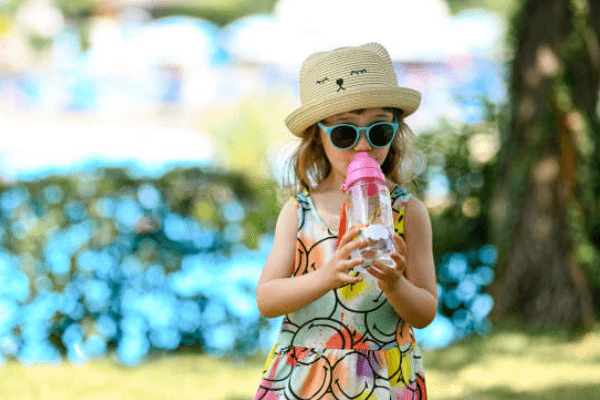Health for a lifetime >>>> How to protect child from the heat
How to protect child from the heat

The heat is an important reason to change the rules of child care. To protect a child from the heat, it is necessary to reconsider the drinking regime, bathing, timing for walks, clothing, and nutrition.
The hot season causes thirst due to thermal overheating of the body and due to excessive sweating, when the body tries to independently establish interaction with the environment and balance body temperature with the ambient temperature. The child’s drinking regime is especially important during the heat, and it changes towards increasing the amount of liquid intake, but not sweet, not salty, not carbonated drinks, but plain water at room temperature or vitaminized weak tea (a cool drink, but not chilled in the refrigerator). Sweet and salty drinks are avoided due to the fact that they again cause thirst, and the intake of excess liquid increases sweating, can provoke swelling of the tissues and, ultimately, creates uncomfortable living conditions for the child. Ice cream is given to young children in a melted form. Carbonated water or carbonated lemonade should not be given to a child during a hot period, since excess gas in the intestines will create the preconditions for painful sensations in the abdomen.
Choosing juice to drink in hot weather requires caution, since tomato juice is usually prepared with the addition of salt, and salt retains water and disrupts heat exchange. Too sweet juices (sweet juices with added sugar) can provoke thirst (for example, carrot, pumpkin, pear, plum, grape). For this reason, the best choice of juices is juices from sweet and sour fruits or vegetables (for example, peaches, citrus fruits, or mixed tomato-carrot juice).


Unlike an adult, a small child will not ask to take a shower; for this reason, parents themselves will have to be guided by their personal experience when and for how long the child needs to take a shower or wash himself with water from a basin or bathtub to avoid overheating. To prevent your child from overheating from excessively high ambient temperatures, it is necessary to give him the opportunity to splash around in the bathtub or shower more often if there are no bodies of water nearby for swimming. The ideal solution is to install an inflatable pool in the local area of a private house or cottage.
During hot times, when the ambient temperature reaches 80-86 degrees Fahrenheit (27-30 degrees Celsius) or more, outdoor walks should be moved to the morning and evening, when the sun's rays and temperature have not yet reached their daily peak or are already decreasing in intensity. This time starts at 6 a.m. and lasts until 11 a.m. (and in cases where the temperature rises beyond 86 degrees Fahrenheit (30 degrees Celsius) - until 10 a.m.). Evening walks are taken from five o'clock in the afternoon until the time chosen for bed.
Since children of different ages have very different wardrobes, the choice of clothing during hot periods is made according to age. For children under one year old, it is recommended to choose clothes made from natural and fine fibers (poplin, twill, satin, cambric), but with a cut that completely covers the arms and legs, light socks, a cap or scarf are allowed. For children over one year old, clothes are chosen in a more open style - short sleeves, short pants and short skirts (sundresses); panama hats, scarves or caps made of natural fiber are chosen as headwear. The style of clothing should be loose-fitting so that the child does not rub the skin in close contact with the fabric during sweating. Sandals for a child should be as open as possible and fit comfortably on the foot. It is acceptable to wear short socks made of natural fabric under sandals.
Despite the fact that a child needs sunlight to prevent many diseases of the musculoskeletal system, direct exposure to sunlight on a child’s delicate skin can cause burns. To avoid painful sunburn while still leaving your child exposed to large areas of the body, you can use a sunscreen made specifically for children. The instructions for the cream indicate the permissible age of the child at which you can start using this cream.
Heat not only changes the heat exchange regime, which must be monitored, but it also affects the digestive processes. In hot weather, the body does not require high-calorie foods, and the diet may change towards fewer meals. But in children, the diet cannot be disrupted; for this reason, it is not the number of meals that is changed, but the portion sizes and caloric content of foods in the direction of reducing them.
In hot weather, it makes sense for a child to eat light fruit or vegetable purees, avoid baked goods made from too heavy dough (fatty) and too sweet baked goods. It is better to leave buns and pies for the second half of the day, and change the filling in such dishes from meat to vegetable, curd or cheese, egg or herbs. Soups made from vegetables, lean fish and (if the child is old enough) then seafood are the most successful menu item in the heat. Fried meats and deep-fried foods are not suitable for eating in hot weather, even if the child is accustomed to such foods in normal situations.
Heat changes the body's response to excessive temperatures, and this affects the health of a child to a greater extent than the health of an adult. The child’s thermoregulation regime may not be properly regulated, and the child is not yet able to independently cope with the inconvenience of high ambient temperatures.

Read

Read



























